On a wet Thursday morning, a fleet manager in Phoenix watched an alert flash on a tablet.
The message came from a connected system that had seen a sudden lane obstruction and pushed a route update to nearby cars. The manager routed two trucks away from the hazard, and a small pileup was avoided.
This scene shows how artificial intelligence and connected sensors work together to make fast decisions on U.S. roads. Real-time perception, radar and camera fusion, edge GPUs, HD maps, and 5G/V2X links let systems detect obstacles, plan paths, and update software over the air.
Leaders such as Waymo, Tesla, NVIDIA, and Cruise use simulation and synthetic data to test rare events off public streets. This article will explain how the autonomy stack, telematics, and continuous diagnostics aim to reduce crashes and keep traffic moving toward a safer future.
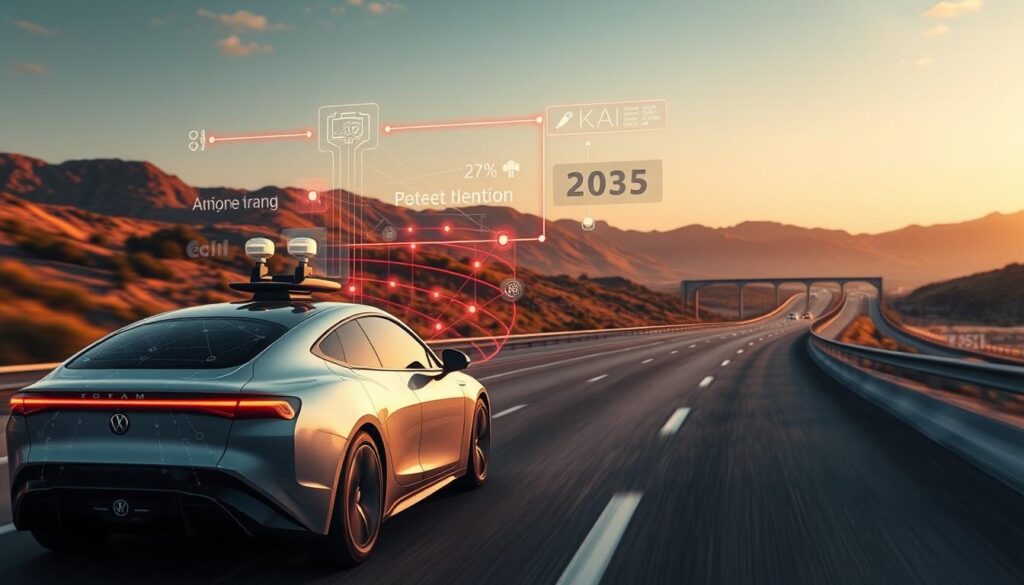
Key Takeaways
- How artificial intelligence and telematics converge to boost road safety in 2025.
- Main components: perception, prediction, planning, and control for autonomous vehicles.
- Edge GPUs, HD maps, and 5G/V2X deliver millisecond decisions for critical moves.
- Simulation and synthetic data help validate behavior without public-road risk.
- Fleet tools and OTA updates speed diagnostics and repair to lower downtime.
The 2025 Landscape: How AI and IoT Are Shaping Autonomous Vehicles in the United States
By 2025, networks of sensors and powerful on-board processors have reshaped how cars sense and react.
Artificial intelligence now functions as the on-road brain. Onboard GPUs handle streams from cameras, LiDAR, and radar to spot obstacles and plan routes in milliseconds.
High-definition maps add centimeter-level context. Cloud services push map updates and large model training, while edge compute runs real-time inference inside each vehicle.
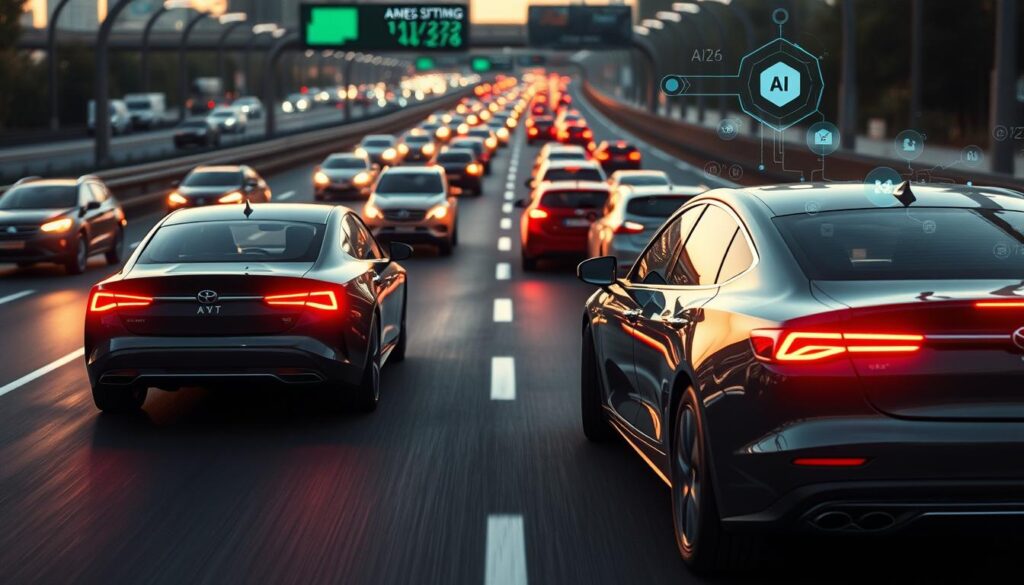
- 5G and V2X enable fast updates, cooperative awareness, and remote diagnostics that improve traffic flow and reduce delays.
- Consortia collect petabytes of driving data and use simulation to cover rare situations and complex intersections.
- Automakers, mapping providers, and software companies partner to scale reliable systems across U.S. roads.
| Component | Role | Impact on Roads |
|---|---|---|
| Edge Compute | Real-time inference on-board | Lower latency for split-second maneuvers |
| HD Maps | Centimeter localization | Better lane and sign recognition |
| 5G / V2X | OTA updates & cooperative alerts | Faster traffic coordination |
| Simulation | Generative scenarios for rare events | Accelerated development and testing |
Despite rapid progress, dynamic construction zones and unpredictable human behavior remain key situations for ongoing development. The goal is clear: reduce crashes, widen mobility access, and smooth traffic across cities and interstates.
Inside the Autonomous Driving Stack: From Perception to Control
The stack organizes raw sensor inputs into timely, reliable outputs that guide every maneuver on the road.
Perception fuses data from cameras, LiDAR, radar, and ultrasonics to produce object lists and lane geometry. CNN-based computer vision powers semantic segmentation, traffic signs recognition, and robust object detection under varied lighting. Redundancy and calibration preserve accuracy when sensors face occlusion or noise.
Prediction uses sequence models and probabilistic learners to forecast pedestrian and vehicle motions. These forecasts let planners reduce conflict points and choose safer paths before hazards appear.
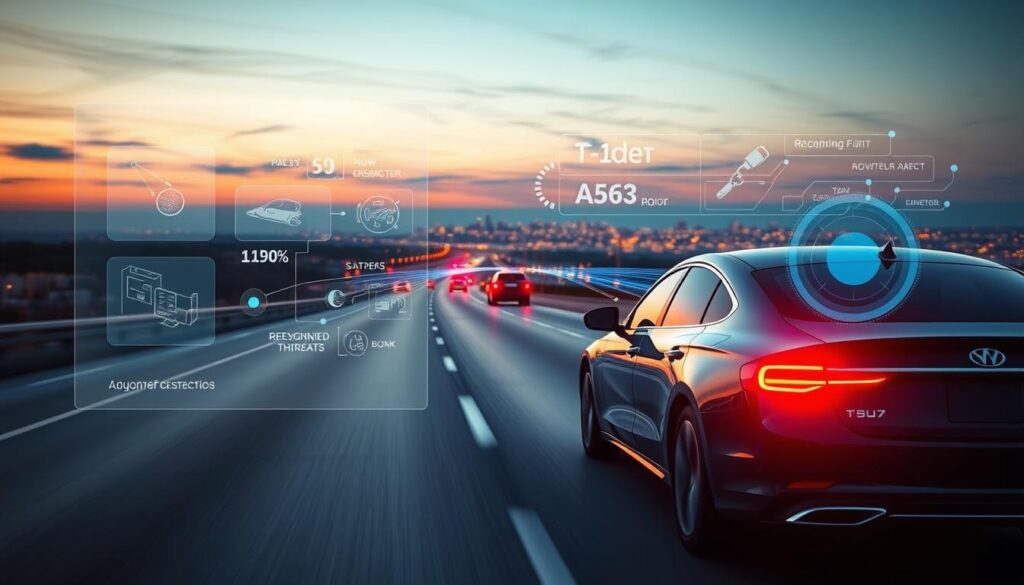
Path Planning and Decision Making
Path planning combines rule-compliant optimization, reinforcement learning, and MDPs to balance comfort, efficiency, and legal compliance. Algorithms weigh options, score trajectories, and make split-second decisions to handle merges, turns, and lane changes.
Control and Actuation
Control layers translate planned trajectories into steering, throttle, and braking commands. Model predictive control anticipates future states, while neural controllers and feedback loops refine actuation for smooth response and precise control.
| Layer | Main Methods | Key Output |
|---|---|---|
| Perception | CNNs, sensor fusion | Objects, lanes, traffic signs |
| Prediction | Sequence models, probabilistic forecasts | Trajectories of pedestrians and vehicles |
| Planning | RL, MDPs, optimization | Trajectories and maneuvers |
| Control | MPC, neural controllers | Actuation commands |
Across layers, low decision latency and synchronized subsystems keep cars responsive. Sensor fusion anchored to HD maps secures lane-level localization and improves detection of vulnerable road users. Together, these systems raise accuracy and help fleets operate more reliably in complex traffic.
Technological Enablers for Safe Autonomy in 2025
Local inference on powerful hardware prevents cloud latency from affecting critical control cycles.
Onboard compute and GPUs sustain real-time perception, planning, and control. Multicore CPUs and GPU accelerators run neural networks for sensor fusion and computer vision with deterministic schedules. Companies such as NVIDIA and Intel optimize frameworks so inference meets strict time budgets and redundancy demands.
High-definition maps built from LiDAR and camera sweeps give centimeter-level localization. These maps add lane geometry, speed limits, and traffic control context that improve positioning and reduce margin-of-error on the road.
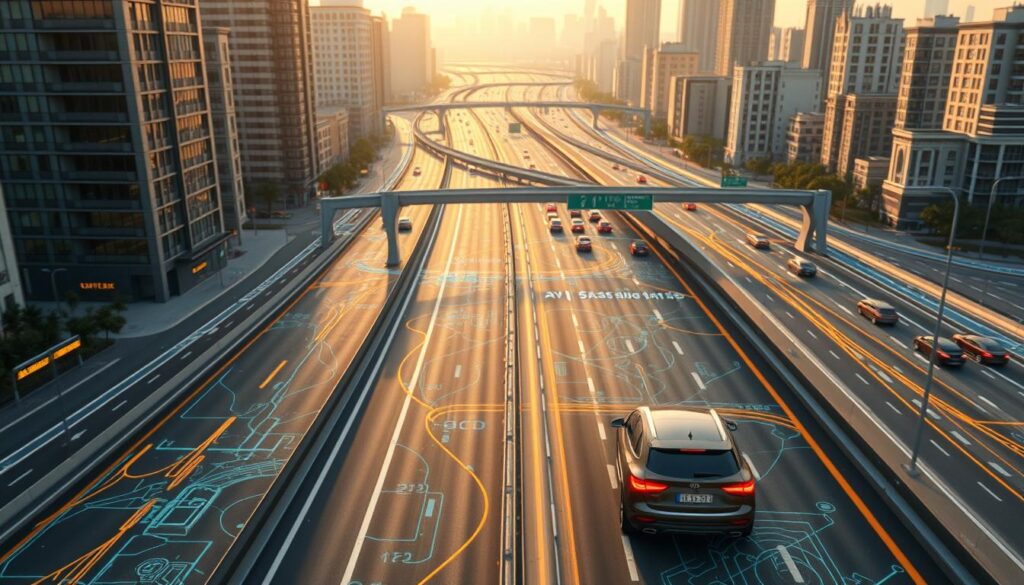
5G, V2X and data at scale
High-speed networks support OTA updates, cooperative messages, and real-time diagnostics. 5G and V2X let cars share alerts and receive map patches with low latency.
Massive driving datasets from fleets and simulation fuel model development. Large, diverse data sets help models generalize across U.S. regions and weather. Improved sensor resolution and dynamic range boost detection in low light and adverse conditions.
| Enabler | Role | Benefit |
|---|---|---|
| Edge GPUs | Real-time inference | Deterministic control loops |
| HD Maps | Lane-level context | Improved localization |
| 5G / V2X | Connectivity | Faster updates & cooperative alerts |
| Large Datasets | Model training | Robust generalization |
AI autonomous driving safety, IoT vehicle monitoring, self-driving prevention
A mix of real-time detection, emergency braking and lane-keeping now forms the first line of collision avoidance.
From ADAS to Autonomy: Preventing collisions with real-time detection and AEB
Real-time detection fuses feeds from cameras and short-range sensors to flag hazards. When algorithms judge risk, automatic emergency braking (AEB) and lane assist act within milliseconds.
These baseline systems scale into higher levels of autonomy by sharing decisions with planners and actuators. Sign and signal recognition helps cars behave lawfully and predictably at intersections.
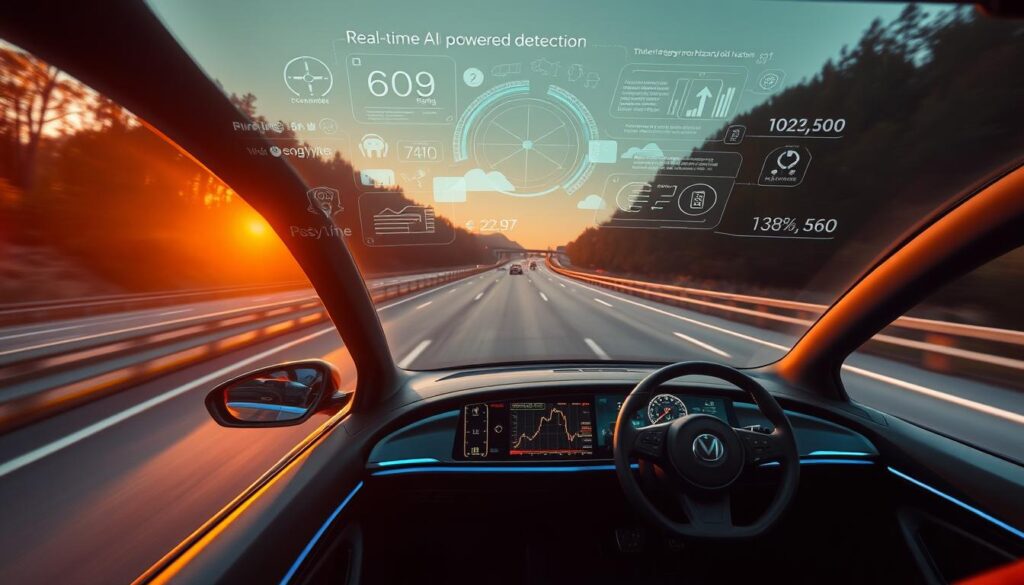
Driver and Occupant Monitoring for safe handoffs and attention assurance
Driver-facing cameras and behavior models verify readiness for smooth handoffs. Clear HMI prompts and tactile alerts guide drivers to take control when systems request it.
Fleet-Scale IoT Vehicle Monitoring: Telemetry, diagnostics, and maintenance alerts
Telematics streams health data and diagnostics to fleet operators. Over-the-air updates patch software, tune models, and push bug fixes that improve overall performance.
Explainable AI to increase trust, transparency, and regulatory readiness
Interpretable outputs show why a decision fired, aiding engineers and regulators during post-incident reviews. Traceable logic supports compliance with standards such as ISO 26262 and builds user trust.
- Connected ADAS: AEB, lane-keeping, and detection form a prevention-first stack.
- Maintenance: Predictive alerts reduce downtime and hidden faults.
- User experience: Timely alerts, clear prompts, and transparent reasoning improve driver confidence on every road.
Connectivity That Protects: IoT Systems Powering Safer Self-Driving Cars
Connected networks now act as a safety backbone, moving updates and alerts where they belong fast.
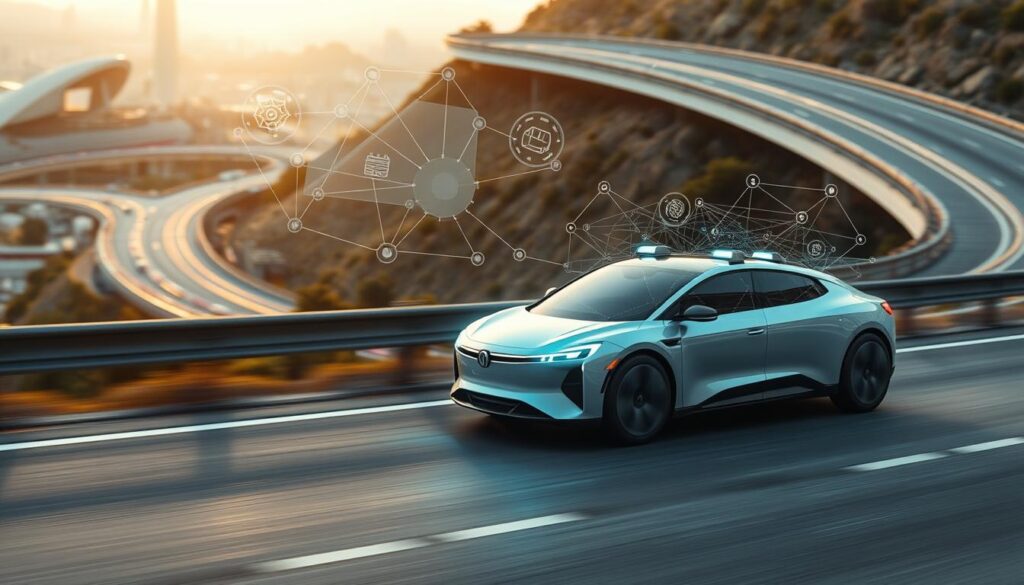
Telematics gathers health metrics and performance data from fleets. This stream shows sensor status, actuator response times, and error logs. Engineers use the data to spot trends and tune systems before problems surface.
Over-the-air updates roll out bug fixes, perception upgrades, and calibration patches on a controlled cycle. Rapid OTA distribution reduces downtime and keeps cars running the latest code without service visits.
V2X Communications
V2X messages broadcast hazards, weather alerts, and work-zone notices. Cooperative merging and signal phase timing help smooth traffic and cut conflict points. These messages improve situational awareness for nearby vehicles and infrastructure.
Edge vs. Cloud
Time-critical perception and control remain on-vehicle so decisions stay deterministic when links drop. The cloud aggregates telemetry, trains models, and recommends fleet policies. Together they balance low latency with large-scale learning.
Localized events—weather cells or incidents—are shared fleet-wide to enable proactive rerouting and reduced congestion. Major companies now offer end-to-end connectivity stacks that prioritize secure, reliable links and clear decision authority at the car level.
| Capability | Where It Runs | Benefit |
|---|---|---|
| Telemetry & Health | Edge capture, cloud aggregation | Faster diagnostics and predictive maintenance |
| OTA Updates | Cloud distribution, edge install | Rapid fixes and feature rollout |
| V2X Alerts | Edge broadcast & receive | Shared hazard awareness, smoother traffic |
| Model Training | Cloud | Fleet-wide improvements and analytics |
Testing What Matters: Generative AI, Simulation, and Synthetic Data
Digital twins and physics engines let developers stress-test planning and control under millions of scenarios.
Synthetic environments recreate rare, high-risk situations—jaywalking, aggressive merges, and sudden obstructions—without endangering the public. These labs let teams measure how perception and path planning behave when conditions are extreme.
Data augmentation adds weather, lighting, and asset variability so models generalize. Techniques include glare simulation, wet-road textures, occlusion modeling, and varied object appearance for more robust object detection.
Validation at Scale
Millions of simulated miles stress-test algorithms before real-road rollout. Teams use scenario coverage metrics, accuracy thresholds, and failure-mode analysis to judge readiness.
“Waymo runs tens of millions of virtual miles per day to probe edge cases.”
- Industry examples: Waymo’s virtual miles, Tesla’s FSD simulation, NVIDIA Drive Sim, Cruise’s digital cities.
- Precise sensor and texture modeling boosts perception fidelity and better trains driver models for varied behavior.
- Simulation shortens development time and speeds safer releases to cars and fleets.
Benefits and Impact in 2025: Safety, Mobility, and Efficiency
Predictive sensing and consistent rule adherence aim to reduce crashes that stem from human delay.
Enhanced safety results from systems that react faster than people and follow traffic rules reliably. Studies show lane departure warnings and automatic interventions cut certain crash types by measurable percentages. This lowers injuries and emergency response time on U.S. roads.
Mobility gains expand access. Autonomous shuttles and ride-hailing services extend trips for seniors and people with limited mobility. More shared options shrink first- and last-mile gaps and improve transit reach.
Operational and environmental efficiency
Fleet coordination, optimized routing, and platooning reduce fuel use and congestion. Predictive maintenance uses data to cut downtime and lower operating costs for logistics and public transit.
As fleets electrify, smoother traffic flow and fewer idle cycles translate to smaller emissions per mile.
“Computer-controlled systems promise more consistent compliance with signs and rules, improving accuracy in complex scenarios.”
User trust and productivity
Predictable behavior, clear feedback, and transparent explanations build acceptance. Passengers reclaim time for work or rest while cars handle routine travel.
| Benefit | Quantified Impact | Who Wins |
|---|---|---|
| Crash reduction | Lowered human-error incidents by an estimated 20–40% in tested scenarios | Drivers, pedestrians, first responders |
| Operational cost | Up to 15% savings via route optimization and predictive maintenance | Logistics operators, transit agencies |
| Accessibility | Expanded service coverage for seniors and disabled riders | Communities and public transit users |
| Emissions | Reduced idle time and smoother flow cuts emissions as fleets electrify | Cities and regulators |
Challenges and Risk Management on the Road to Full Autonomy
Protecting communication channels and ensuring reliable failover are central to risk management for modern vehicles.
Cybersecurity, software reliability, and redundancy
Hardening communications is essential: encrypted links, secure OTA pipelines, and intrusion detection guard fleets from remote compromise.
Engineers pair that with redundancy and failover. Multiple compute lanes, watchdogs, and cold-start recovery reduce the chance of a control or perception outage.
Weather, perception limits, and sensor fusion complexity
Precipitation, fog, and low light degrade sensors and complicate sensor fusion. Robust calibration, adaptive filters, and model retraining help maintain object and sign recognition under harsh conditions.
Testing across varied conditions and synthesizing rare situations improves algorithms and prepares systems for edge scenarios on the road.
Ethics, liability, and U.S. regulatory compliance (ISO 26262)
Clear decision frameworks and audit trails make it easier to assign liability and meet U.S. standards. ISO 26262 practices guide systematic development, traceability, and functional validation.
Human factors matter: driver monitoring, explicit handoff prompts, and limits on system capabilities prevent misuse and overreliance by drivers.
“Comprehensive logging and explainable outputs support root-cause analysis and regulatory review.”
- Map and signage variability require runtime checks and fallback behaviors for temporary work zones.
- Incident response needs traceable logs, explainability, and fast update cycles to fix faults in the field.
Conclusion
Bringing together sensor intelligence, fleet connectivity, and realistic simulation shortens the time from lab to lane.
Artificial intelligence supplies core perception, prediction, planning, and control that make cars responsive. Connected systems deliver OTA updates, diagnostics, and V2X cooperation so fleets learn and adapt faster.
Generative simulation and rich data let teams test rare events at scale without risk. Functional safety practices and explainable outputs help meet U.S. standards and build public trust on every road.
Balanced innovation—focused on robust testing, cybersecurity, and clear explainability—will speed wider adoption. Over time, better models, denser data, and stronger edge hardware will cut the time to safer, more reliable vehicles on American streets.
FAQ
What are the core layers of the autonomy stack and how do they work together?
The stack has five main layers: perception (computer vision, traffic sign recognition, object detection using convolutional neural networks), prediction (behavior forecasting for pedestrians, cyclists, and other vehicles), planning (path planning and decision making using reinforcement learning, Markov decision processes, and rule compliance), control (model predictive control and neural controllers with feedback loops), and localization (sensor fusion of cameras, LiDAR, radar, ultrasonics, and high-definition maps). Each layer feeds the next: perception detects, prediction forecasts intent, planning chooses safe trajectories, control executes maneuvers, and localization keeps the system positioned in the world.
How do onboard compute and edge inference affect real-time performance?
Modern systems rely on powerful GPUs and specialized accelerators mounted on the vehicle to run neural networks at low latency. Edge inference reduces round-trip time compared with cloud processing, enabling timely emergency braking, obstacle avoidance, and lane-keeping. High-throughput compute paired with optimized models ensures decisions occur within the tight time budgets required for safety.
What role do HD maps and sensor fusion play in accurate localization?
High-definition maps supply centimeter-level landmarks and road geometry that complement on-board sensors. Sensor fusion merges data from cameras, LiDAR, radar, and GPS to reduce individual sensor weaknesses. Together they improve positional accuracy, keep the system robust in tunnels or urban canyons, and support precise path planning and control.
How can telematics and over-the-air updates improve safety after deployment?
Telematics collect telemetry, diagnostics, and driving metrics from fleets. Engineers use that data to spot failure modes and tune models. Over-the-air updates let manufacturers deploy software patches, perception model improvements, or configuration changes without physical recalls. This continuous delivery loop tightens safety and reliability over time.
What testing methods address rare edge cases and adverse weather?
Developers combine real-world data with synthetic environments and simulation. Generative approaches and data augmentation introduce varied weather, lighting, and scene variability so models see rare conditions during training. Closed-loop simulators, such as NVIDIA Drive Sim or Waymo’s virtual miles, reproduce edge cases repeatedly for validation before road deployment.
How does fleet-scale telemetry help with maintenance and operational efficiency?
Fleet telemetry streams diagnostics and sensor health metrics to central systems. Predictive maintenance algorithms flag components at risk, schedule service, and reduce downtime. For logistics and ride-hailing, this improves uptime, fuel efficiency, and operator routing decisions while lowering total cost of ownership.
What are the main cybersecurity and software reliability concerns?
Risks include remote compromise of telematics, corrupted model updates, and denial-of-service attacks on connectivity links. Mitigations use secure boot, signed updates, redundancy across sensors and compute, intrusion detection, and rigorous software verification. Functional safety standards like ISO 26262 guide reliability and failure-mode planning.
How do V2X and 5G enhance coordination and hazard awareness?
Vehicle-to-everything communications and 5G enable low-latency sharing of road conditions, traffic signals, and hazard warnings between vehicles and infrastructure. That shared context augments sensors for occluded hazards, cooperative maneuvers, and smoother traffic flow, particularly in dense urban corridors.
What is explainable model design and why does it matter for regulation?
Explainable design produces models and decision logs that humans and regulators can inspect. Transparent reasoning, causal attribution, and interpretable behavior traces build trust and make it easier to demonstrate compliance with safety standards and liability frameworks during investigations.
Which industry examples show current progress in simulation and testing?
Leading programs include Waymo’s large-scale virtual miles, Tesla’s FSD simulation fleet, NVIDIA Drive Sim for hardware-in-the-loop validation, and Cruise’s digital city environments. Each combines real-world telemetry with synthetic testing to accelerate corner-case discovery and model hardening.
How do perception limits and weather affect system performance?
Adverse weather and low visibility degrade camera and LiDAR returns and increase false negatives. Sensor fusion helps, but systems must detect degraded conditions and adjust behavior—slowing, rejecting automation, or handing control to a human. Robust models, redundant sensors, and conservative planning mitigate risk.
What measures ensure safe handoffs between automated systems and human drivers?
Driver and occupant monitoring systems track gaze, head pose, and engagement. When the system detects inattention or an inability to take control, it issues graded alerts, attempts gentle interventions, and, if necessary, performs a safe stop. Clear human-machine interfaces and defined handoff procedures reduce confusion.
Transform Your IoT Vision Into Reality.
Get free expert insights, architectures & cost breakdowns.
Drop your email to schedule free meeting.